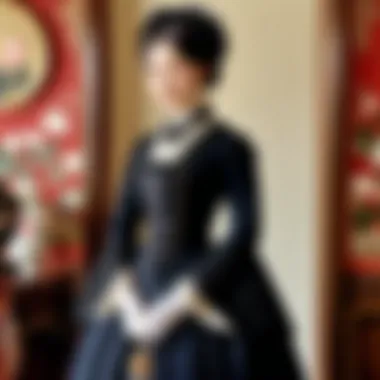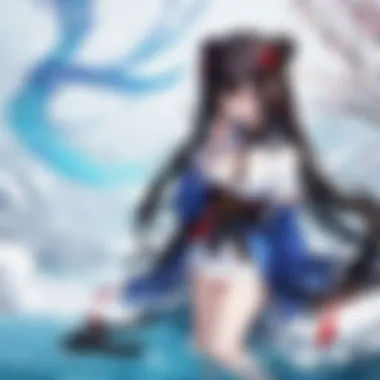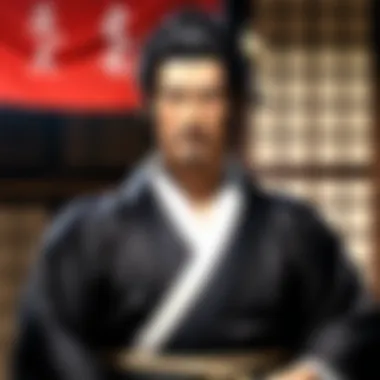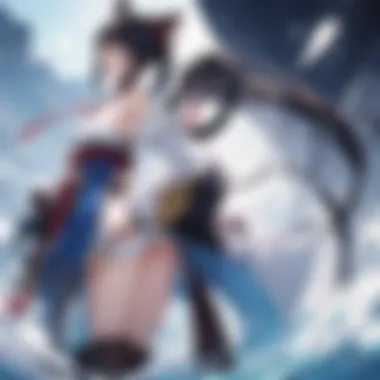A Deep Dive into the World of Kuroshitsuji


Prolusion to the Series
Kuroshitsuji, also known as Black Butler, is a captivating blend of dark fantasy and supernatural elements depicted through both manga and anime formats. Created by Yana Toboso, the series first made its debut in manga form in 2006, followed by an anime adaptation that premiered in October 2008. Kuroshitsuji's plot is set in Victorian-era England, centered on the young Earl Ciel Phantomhive and his enigmatic butler, Sebastian Michaelis.
The narrative intricately intertwines themes of revenge, loyalty, and the eternal struggle between good and evil. The series brings forth complex characters that reflect both their internal conflicts and the broader societal implications of their actions. The portrayal of Victorian society, together with supernatural elements, offers a rich tapestry for exploration and interpretation.
The popularity of Kuroshitsuji has been immense. It has cultivated a dedicated fan base both in Japan and internationally. With its unique aesthetic and compelling narrative, the series has often been praised not only for its engaging storyline but also for its artistry. Fans appreciate the combination of intricate plots with character development that provides substance beyond mere entertainment. The anime adaptation further enhanced its reach, solidifying its place in the hearts of many.
Overall, Kuroshitsuji stands out as a remarkable series that successfully marries gothic elements with rich storytelling, making it a significant cultural piece in the realm of anime and manga.
Preface to Kuroshitsuji
Kuroshitsuji, also known as Black Butler, holds a significant place in the realm of anime and manga. This article begins by highlighting the importance of understanding this series within the larger context of modern storytelling. Not only does it weave elements of horror, comedy, and mystery, but it also delves deeply into themes of duty, morality, and the human condition. By examining Kuroshitsuji, readers can appreciate how it blends traditional Victorian aesthetics with supernatural elements, creating a unique narrative experience.
Overview of the Series
Kuroshitsuji follows the story of Ciel Phantomhive, a young earl bound by a contract to his demonic butler, Sebastian Michaelis. The narrative unfolds in a gothic atmosphere characteristic of the Victorian era, infusing it with complex characters and intricate plotlines. Ciel’s quest for revenge drives the narrative, while Sebastian embodies the qualities of a classic butler, yet with dark, supernatural undertones. This blend raises questions about loyalty, the nature of evil, and the cost of ambition.
The series has received acclaim for its elaborate artwork and compelling characters. It presents an engaging mix of genres, attracting a diverse audience. The themes explored resonate deeply with viewers, making it not only entertaining but also thought-provoking.
Creation and Development
Kuroshitsuji originated as a manga written and illustrated by Yasana Kuroshitsuji was populair in Japan since its debut in 2006. The series quickly gained a loyal following, leading to various adaptations, including an anime series, stage plays, and even live-action films. The appeal lies in its visually striking art and a story that transcends simple entertainment, drawing on literary references and historical contexts.
Each character is richly developed, reflecting social dynamics and personal struggles, particularly in the context of Victorian England. Themes of loss, power, and morality are explored through Ciel and Sebastian's interactions, ultimately showcasing how personal agendas can conflict with ethical obligations. The evolution of characters through their experiences allows for deeper narrative analysis, revealing the intricate layers of human emotion and motivation.
This comprehensive examination of Kuroshitsuji aims to illuminate not only its artistic merits but also its contributions to discussions around character complexity and narrative depth. Understanding these elements enhances appreciation for the series, making it relevant in both the anime community and broader cultural conversations.
Historical Context
Understanding the historical context of Kuroshitsuji is crucial in appreciating its narrative and thematic depth. Set against the backdrop of Victorian England, the series combines real historical elements with fantastical components. This blend not only serves to enhance the storytelling but also provides a window into the societal norms and expectations of the era.
Victorian England as a Setting
Victorian England, marked by its strict social hierarchy, industrial revolution, and intricate class distinctions, serves as a rich setting for the narrative of Kuroshitsuji. The series cleverly depicts this world, highlighting issues of class, morality, and the supernatural. The character of Ciel Phantomhive, as a young earl, embodies the struggles of the aristocracy during this period. The opulence of the upper class contrasts sharply with the dark undertones of servant life, symbolized through the character Sebastian Michaelis.
The series frequently employs this setting to reflect on the complexities of power dynamics and the roles individuals play within society. The manor in which Ciel resides functions as a microcosm of Victorian society, filled with both grandeur and hidden darkness. The audience is drawn not only into the aesthetic representation of the time but also into the moral quandaries faced by its characters.
Influences from Literature
Kuroshitsuji draws heavily from a variety of literary sources, enriching its narrative layers. One clear influence is classic Gothic literature, which explores themes of horror, the supernatural, and psychological intricacies. Works by authors such as Charles Dickens and Mary Shelley resonate throughout the series, reflecting issues like social injustice and the duality of human nature.
Moreover, the Demon Butler trope is evident in literature, where characters like Sebastian Michaelis challenge traditional roles of servitude. This character not only serves his master but also navigates realms beyond human comprehension, thus merging the ordinary with the extraordinary. Literary influences allow viewers to recognize the depth of character motivations and the broader implications of their actions.


In essence, the historical context of Kuroshitsuji offers a profound framework that enhances the viewer's experience. This interplay of Victorian society and literary references engages audiences more deeply, inviting continuous analysis and discussion.
Character Analysis
In any narrative, the characters are the lifeblood that drives the story and engages the audience. In Kuroshitsuji, the careful crafting of its characters plays a crucial role in not only advancing the plot but also in embodying the series' deeper themes. A thorough character analysis allows us to delve into the personalities, motivations, and conflicts that define the series, leading to a richer understanding of its narrative framework and emotional resonance.
Through the lens of character analysis, we see how the complex interplay between the central figures and their supporting cast creates a multi-dimensional world. Each character brings unique attributes and struggles, which allows viewers to connect on various levels. Understanding these layers is essential for appreciating how Kuroshitsuji transcends mere entertainment, inviting reflection on broader societal issues, morality, and the human condition.
Sebastian Michaelis: The Complex Butler
Sebastian Michaelis stands as one of the most intriguing characters in Kuroshitsuji. As the personal butler to the young Earl Ciel Phantomhive, Sebastian embodies a paradox. His poise, elegance, and unmatched skills are contrasted by his demonic nature. This juxtaposition serves to heighten the allure and mystery surrounding him.
Sebastian’s character is not only defined by his supernatural abilities but also by his unwavering loyalty to Ciel. This bond raises questions about the nature of servitude and companionship. Unlike typical depictions of a butler, Sebastian is cunning and often manipulative. He aims to fulfill Ciel's contract with an endpoint that only he fully understands.
This complexity allows for nuanced interactions. Sebastian's dialogue often carries layers of meaning that reflect not just his character but also the themes of class and power dynamics within the Victorian setting. By examining his actions and motivations, we gain insight into the broader implications of loyalty, ambition, and the consequences of ambition.
Ciel Phantomhive: The Young Earl
Ciel Phantomhive is the embodiment of youthful ambition twisted by tragedy. As a young earl who has endured tremendous loss, his character serves as a vessel through which themes of vengeance and sacrifice are explored. Ciel’s journey is marked by a thirst for revenge against those who wronged him, which aligns him with darker forces.
His relationship with Sebastian is both a source of strength and moral conflict. Ciel’s dependency on his butler's powers suggests a loss of innocence and autonomy. Ultimately, Ciel’s character arc raises questions about the costs of revenge and the sacrifices one must make for reclaiming lost power—his soul becomes intertwined with the notion of contracts.
Ciel’s motivations are deeply relatable, tapping into human emotions such as grief, anger, and a desire for justice. Through him, the narrative explores the implications of choices made under duress and their long-lasting effects on identity and morality.
Supporting Characters: Significant Roles
The supporting characters in Kuroshitsuji, such as Grell Sutcliff and Elizabeth Midford, serve to enrich the narrative fabric. Grell, a flamboyant reaper, embodies the chaotic energy that contrasts sharply with Sebastian's composure. This character operates in duality, highlighting the intricacies of life and death.
Elizabeth, Ciel's betrothed, adds an emotional layer to Ciel’s life, representing innocence and hope. Their interactions bring light to the darker themes, emphasizing what is at stake in Ciel's quest for vengeance. Each supporting character, through their actions and interactions, sheds light on the main characters, offering perspectives that further inform the storyline.
Themes and Motifs
The exploration of themes and motifs in Kuroshitsuji plays a crucial role in understanding the narrative and character dynamics throughout the series. Central to its story are ideas that resonate deeply with audiences and enhance the viewing experience. The thematic elements are intricately linked, forming layers that add depth to the plot and the characters.
The Nature of Contracts
Contracts in Kuroshitsuji are not mere agreements; they symbolize the intricate binding between Sebastian Michaelis and Ciel Phantomhive. These contracts echo broader ideas of morality and power. Each pact has weight, suggesting a trade-off between the human soul and supernatural assistance. The notion of contracts raises significant questions about the ethics of one's decisions and the consequences they entail.
Contracts reveal characters' desires and motivations. For instance, Ciel's pact stems from a quest for revenge against those who wronged him. Sebastian, meanwhile, seeks to fulfill his end of the deal while maintaining his own interests.
"Contracts are at the heart of human relationships, portraying a delicate balance of power and trust."
The nuances of these contracts signify that power has a price—a complex idea that challenges viewers to consider how far one would go to achieve their goals. This aspect makes the series intriguing, as both protagonists and antagonists navigate their desires.
Exploring Good and Evil


The duality of good and evil is pervasive in Kuroshitsuji. The characters often embody their moral complexities, blurring the lines between hero and villain. Sebastian, a demon, is portrayed with qualities that can be considered both endearing and sinister. Meanwhile, Ciel, who operates within the bounds of humanity, commits acts that can be classified as morally questionable.
The conflict between good and evil is not explicit; instead, it is a grey area where motivations impact judgment. This thoughtful portrayal invites examination of how circumstances shape individuals' actions. Ciel's struggles exemplify how someone can pursue noble ends through dubious means.
Additionally, the presence of antagonists introduces philosophical discussions about redemption. Characters like the Undertaker and Grell evolving from shadowy figures to complex individuals illuminates the theme that understanding one's past is vital in shaping identity.
The Search for Identity
Identity is a recurring concern in Kuroshitsuji. Characters strive to understand who they are amidst the chaos around them. Ciel’s quest for revenge is not just about retribution; it’s also about reclaiming the identity he lost due to tragic events. His struggle highlights the importance of personal history in shaping one's self-concept.
Sebastian, as a demon, grapples with what it means to serve. His role as a butler raises interesting questions about subservience and autonomy. Are there layers to his identity beyond the contract? The dynamic between Ciel and Sebastian is more than a master-servant relationship; it is one that calls for reflection on the nature of companionship and loyalty.
Supporting characters also contribute to these themes. Each has a story that interlinks with Ciel and Sebastian's journey, providing insights into their individual quests for self-discovery.
Overall, Kuroshitsuji intricately weaves together themes of contracts, morality, and identity, creating a rich tapestry that resonates with its audience. Through these explorations, viewers gain a profound understanding of the series, beyond its surface narrative.
Artistic Elements
Artistic elements play a crucial role in the overall impression and effectiveness of Kuroshitsuji. These elements create an atmosphere that captures the viewer's attention and immerses them in the story. The combination of animation style and musical composition contributes significantly to the series' unique identity and appeal. This section will delve into these aspects to understand their importance and impact.
Animation Style and Techniques
The animation style of Kuroshitsuji is characterized by its detailed character designs and meticulously crafted backgrounds. This attention to detail enhances the narrative experience by establishing a strong visual connection to Victorian England. The use of contrasting color palettes helps to evoke the mood of each scene effectively. For example, darker tones often accompany intense moments, while brighter colors signify lighter interactions.
During action scenes, the fluidity of movement is noteworthy. Techniques like dynamic camera angles and swift cuts maintain a sense of urgency, drawing viewers deeper into the unfolding drama. Additionally, the incorporation of visual effects adds a supernatural dimension that is fitting for the storyline. The blend of traditional animation with digital enhancements results in a product that is visually striking and memorable.
Soundtrack and Musical Composition
The musical composition in Kuroshitsuji is another vital component that elevates its storytelling. The score complements the visual elements, reinforcing the emotional weight of various scenes. Composed by Akiko Saitō, the soundtrack features orchestral pieces that vary in intensity, aligned perfectly with the series' narrative arc.
Themes of suspense and intrigue emerge through haunting melodies, while lighter, more whimsical tracks create a contrast that highlights the series' multifaceted tone. The strategic timing of music during pivotal moments accentuates viewers' emotional responses.
"The soundtrack of Kuroshitsuji is not just background music; it is a character in its own right, guiding audience feeling through the narratives."
Moreover, the opening and ending themes have become significant aspects of the series. Songs like "Monument" by Kaito enhance the introduction's dramatic mood, while ending songs provide closure and reflection. This careful curation of sound reinforces Kuroshitsuji's position as an influential work in both the anime and manga landscapes.
Both the animation style and soundtrack work in tandem to create an immersive universe. These artistic elements not only enhance the storytelling but also help to establish Kuroshitsuji's cultural impact. By paying attention to detail in visual and auditory aspects, the series resonates deeply with its audience—inviting them to explore its narrative richness.
Cultural Impact
Kuroshitsuji has left a significant mark on both the anime and manga industry, illustrating the influence of specific narratives and themes in modern entertainment. The cultural impact of Kuroshitsuji can be assessed through its reception in Japan, the establishment of a global fanbase, and its overall influence on related media. Examining these elements helps illuminate how Kuroshitsuji has become more than just a series; it represents a cultural phenomenon that resonates with a diverse audience.
Reception in Japan


In Japan, Kuroshitsuji was met with enthusiasm and curiosity. When it first appeared in Monthly GFantasy magazine, it quickly gained traction among readers. Its unique blend of humor, horror, and complex characters offered a refreshing take on anime narratives. The popularity led to adaptations in various formats, including anime and live-action productions, solidifying its standing in popular culture.
Reviews often highlight its rich storytelling and beautifully crafted visuals. Fans appreciate the depth of character development and the themes of loyalty, power, and morality.
The series is often credited with contributing to the resurgence of gothic themes in anime, inspiring other works that explore similar aesthetics and narratives.
Moreover, Kuroshitsuji's presence at conventions and in merchandise reflects its strong cultural hold. Products range from collectibles to fashion lines, further enriching its connection with the fan community.
Global Fanbase and Influence
The impact of Kuroshitsuji extends far beyond Japan. Its global fanbase has grown significantly, aided by streaming platforms and social media channels. Fans from various countries engage in discussions, fan art creation, and cosplay, showcasing their dedication to the series. Online communities on platforms like Reddit and Facebook enable enthusiasts to share their interpretations and analyses, further deepening the experience of the narrative data.
Additionally, Kuroshitsuji has influenced Western media. The incorporation of its themes and styles has been noted in both animated and live-action productions. Many creators cite Kuroshitsuji as an inspiration for their works, which underlines its reach and impact.
Overall, the series demonstrates how cross-cultural connections can be formed through storytelling. Kuroshitsuji's blend of unique art styles and themes presents a case study of the global synergy of anime, reaching audiences who value both the aesthetic and narrative complexities it offers.
Adaptations and Spin-offs
The adaptations and spin-offs of Kuroshitsuji are significant in understanding its broader impact. This section highlights how these adaptations have contributed to the series' popularity and cultural relevance. Each format offers different experiences and interpretations of the source material, expanding its reach and audience.
Manga vs. Anime: A Comparison
The Kuroshitsuji manga, created by Yana Toboso, serves as the foundation for its anime adaptations. The manga presents a more intricate narrative and character development, allowing readers to engage deeply with the plot. It also features unique story arcs that are not fully represented in the anime, offering more context and depth.
In contrast, the anime adaptation, particularly the first series produced by A-1 Pictures, optimizes visuals and dramatically enhances action sequences. The animation brings characters to life, capturing the essence of Toboso's illustrations. However, some manga fans have expressed disappointment over narrative gaps in the anime.
"The manga's detailed world and emotional depth often gets lost in the fast-paced nature of the anime."
An important difference lies in the ending. The manga has continued beyond the anime, introducing new characters and storylines that have not been adapted. This has created a divide among fans, with some preferring the more developed plotlines of the manga, while others enjoy the visual appeal of the anime. The anime does appeal to a broader audience but may lack the nuanced storytelling that the manga provides.
Live-Action Adaptations
The live-action adaptations of Kuroshitsuji include films and stage plays. These adaptations take the core narrative and deliver it in a format that adds a new layer of interpretation. The characters are portrayed by real actors, which brings a different dynamic to their relationships and conflicts.
One notable live-action film is Kuroshitsuji: The Movie, which features an all-original story that diverges from both the manga and anime. This adaptation explores a more expansive narrative that integrates new elements while retaining the essence of the original characters. However, reactions to live-action adaptations can be mixed. Some fans appreciate the fresh perspective, while others may find it less compelling compared to earlier versions.
Moreover, the recurring stage plays maintain high production values, from set designs to costumes, closely resembling the manga's aesthetic. They often attract dedicated fans, eager to experience the story in a unique format.
Ending
The conclusion of this article highlights the importance of Kuroshitsuji as a significant work in the anime and manga landscape. This series is not merely a tale of supernatural intrigue; it explores deeper themes that reflect societal norms and psychological conflicts.
Key aspects to consider about Kuroshitsuji include:
- Narrative Complexity: The intertwining plots and the evolution of characters contribute greatly to the series’ depth.
- Cultural Commentary: Through its setting in Victorian England, Kuroshitsuji provides insight into social hierarchies and moral ambiguities.
- Artistic Expression: The distinct animation style and musical score enhance the storytelling experience, creating a more immersive world.
Reflecting on its success, we see that Kuroshitsuji manages to blend horror, comedy, and drama, inviting viewers to engage with its characters and their struggles. As both a piece of entertainment and a cultural artifact, it commands attention. It stands not just as a product of fandom but as an analysis of humanity.
"Kuroshitsuji serves as a mirror, reflecting the complexities of human nature and the demon within that we all must confront."
Understanding Kuroshitsuji allows fans and newcomers alike to appreciate its influence and the artistry behind it. In doing so, one can better recognize the layers of meaning woven into the fabric of the story, solidifying its place in the pantheon of celebrated anime and manga.















